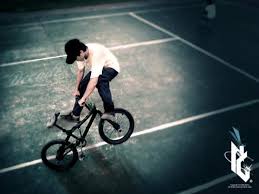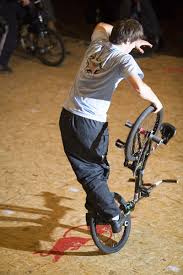ABOUT BMX FLATLAND
Flatland is a freestyle BMX riding style performed on smooth flat surfaces that do not include any ramps, jumps or grind rails. It is sometimes described as a form of artistic cycling with a blend of breakdancing. Flatland as a discipline also encompasses certain aspects Martial Arts.
Flatland occupies a position somewhat removed from the rest of freestyle BMX. People who ride in the above disciplines will generally take part in at least one of the others but flatlanders tend to only ride flatland. They are often very dedicated and will spend several hours a day perfecting their techniques.
Flatland also differs from the others in that the terrain used is nothing but a smooth, flat surface. Tricks are performed by spinning and balancing on the bike in a variety of unexpected positions. Riders almost always use either knurled/grip taped aluminum or plastic pegs to stand on to manipulate the bike into even stranger positions.
Flatland bikes typically have a shorter wheelbase than other freestyle bikes. This shorter wheelbase requires less effort to make the bike spin or to position the bike on one wheel. One of the primary reasons flatlanders often ride only flatland is the decreased stability of using their shorter bikes on ramps, dirt and street.
A variety of options is commonly found on flatland bikes. The most unifying feature of flatland bikes is the use of four pegs, one on the end of each wheel axle. Flatlanders will choose to run a front brake (or a dual front brake, one front brake with two brake levers using one brake cable), front and rear brakes or no brakes at all depending on stylistic preference.
STYLE
STYLE
In competition, talent and skill are judged by the ability to maintain coordination, and balance while performing a variety of difficult and elegant moves. There are usually several categories for judging purposes which can include:
- number of touches where the number of times a trick is not completed and/or the number of touches of the foot to the ground
- number of tricks completed in the allotted time
- difficulty of the tricks which can be very subjective, as flatland techniques have in many ways become as refined as those in figure skating or breakdancing.
- originality of the tricks performed, which again can be somewhat subjective
- style and flow or how smoothly and/or stylishly moves are performed during the contest run
- showmanship the ability to present your routine to the crowd. Hugo Gonzales and Dave Vanderspek, while not the top pros were known for their elaborate showmanship and antics.
Flatland is an involving, time-consuming discipline in which the rider learns different balance/counterbalance points and center-of-gravity in motion techniques through repetition and trial-and-error. Some tricks can be learned in hours, while others may take years to master.
Various riders emphasize different aspects of the discipline: the artistic nature of flatland and the originality of tricks, the number and difficulty of tricks or the simple enjoyment of the activity. Only contest riders need to be concerned with the competitive side of the discipline as there are many riders who prefer doing shows, taking parts in videos or simply riding with their friends and enjoying themselves.
Riders usually pedal a few times for speed, and then perform various stunts often involving difficult and/or awkward stances on pegs, mounted to the axles of their front or back wheels. Pegs are aluminum or plastic tubes, which are bolted onto both sides of the front and back axles. When flatland riding first began, most riders would do one trick and then return to the pedals. However, by combining different body and bicycle positions into "combos" and "linking" them together, riders began to do several tricks in a row without stopping between each move. Flatland riding is now usually a combination of many different kinds of moves, often linked together non-stop as the rider goes through as many as 10-12 consecutive moves and position/direction changes, before returning to the pedals.
PICTURES












PICTURES
No comments:
Post a Comment